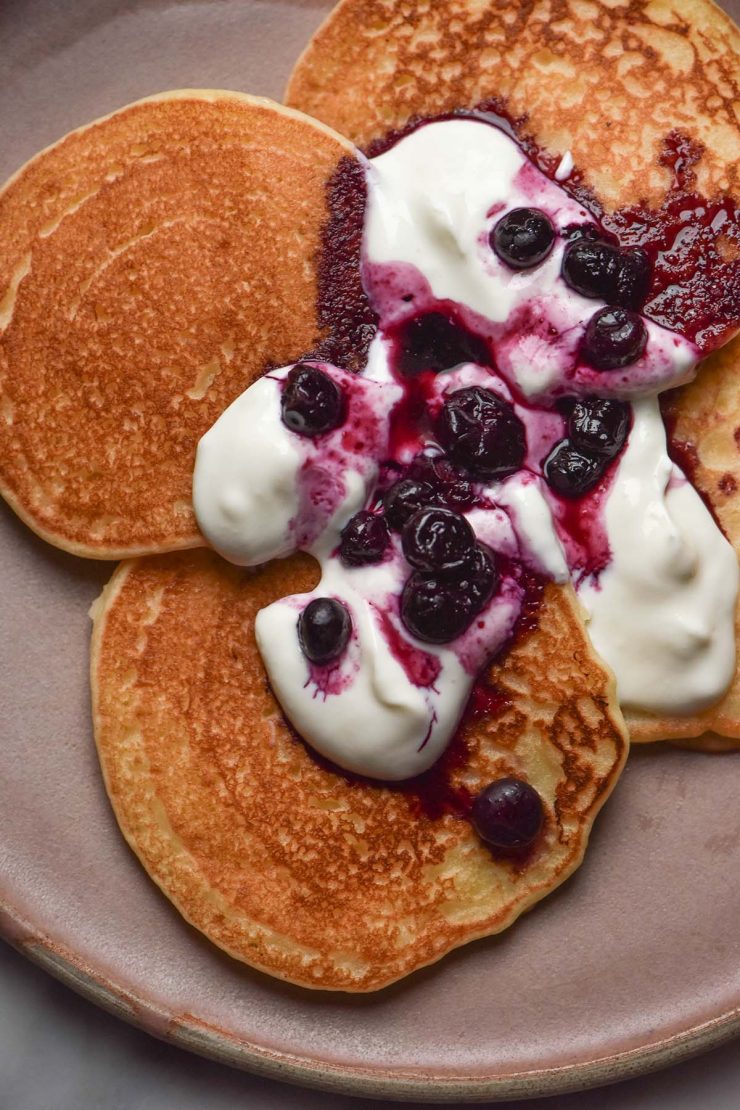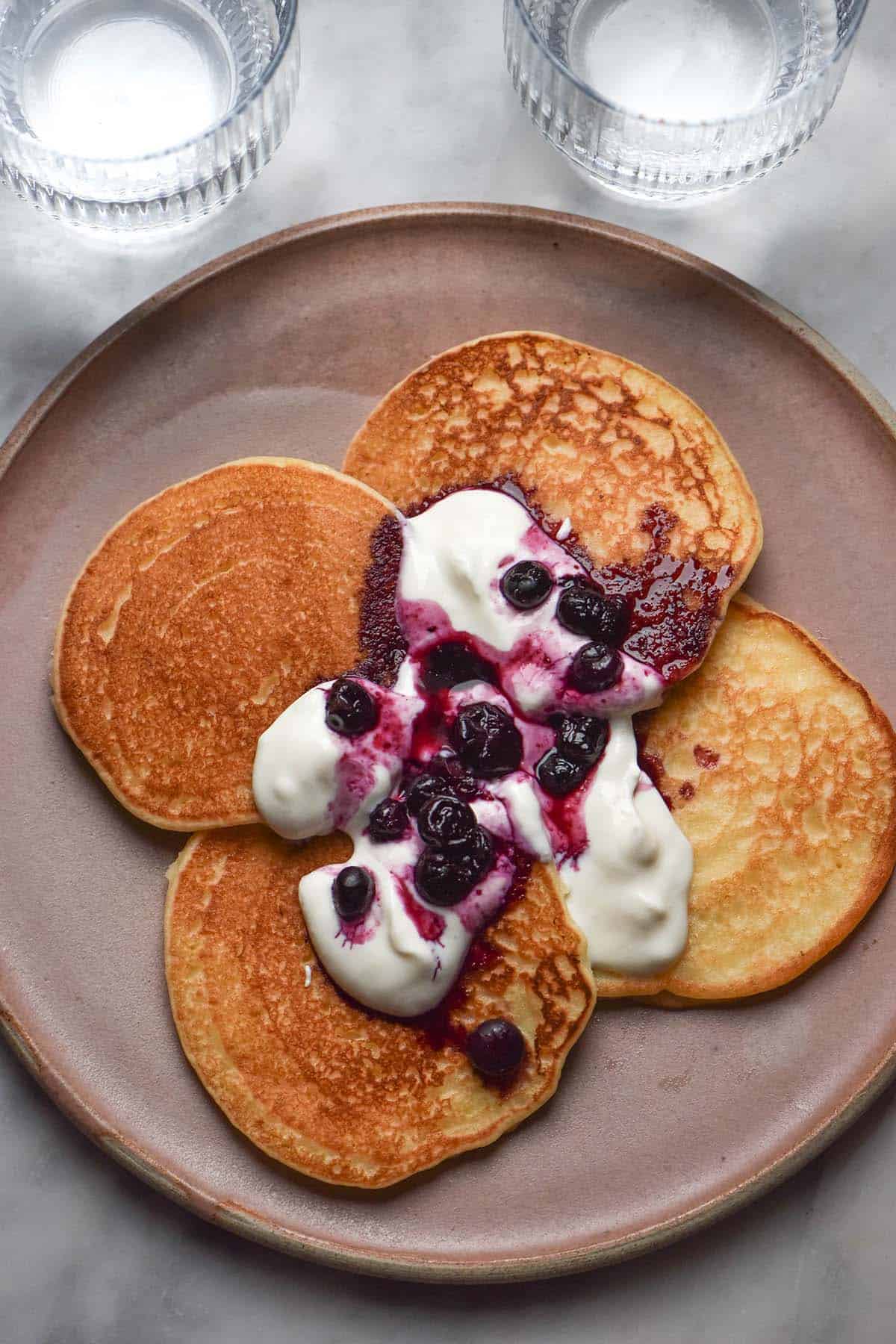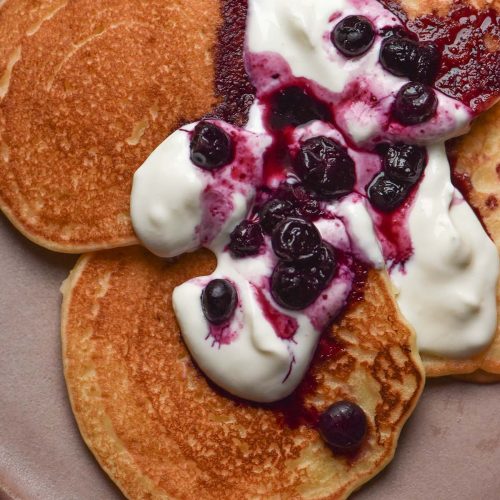
After I published my gluten free cottage cheese pancake recipe recently, I wanted to make sure my dairy free friends were covered. With a bit of tweaking, I am very pleased to publish this easy recipe for gluten free dairy free pancakes. They are free from added xanthan gum, nut free and don’t require any fancy equipment. Simply mix up the dry ingredients, mix up the wet ingredients and mix them together!
Gluten free dairy free pancakes
These pancakes use a simple mix of ingredients for a sweet, fluffy and light end result. The pancakes use a combination of majority fine white rice flour and a small amount of tapioca flour for a neutrally flavoured base with good elasticity. A small amount of sugar provides sweetness, flavour and browning.
They are bound together with eggs, plain coconut yoghurt and a small amount of oil. The eggs, along with some baking powder, provide the leavening – no whipped egg whites required!
Finally, we’re adding a splash of milk as needed and flavourings as desired. I always use a dash of vanilla, a good pinch of fine salt and lemon zest. What you use is up to you!

Dietary and FODMAP notes
To keep these pancakes nut free, choose a nut free plant based yoghurt and milk. I am a coconut yoghurt girl myself. In terms of the milk, my low FODMAP recommendations are rice milk, macadamia milk and soy milk. If you need the pancakes to be low FODMAP and want to use soy, choose soy milk made from soy protein (more on this below).
The pancakes don’t contain any added xanthan gum but coconut yoghurts often use gums. Check the labels and find a brand without gums, if needed. I used Nakula brand here in Australia and they don’t use any gums at the time of writing.
These dairy free, gluten free pancakes are generally low FODMAP. However, there are a few quick bits and bobs to consider.
Firstly, the coconut yoghurt. Check that the yoghurt doesn’t contain chicory or fibres that might be high FODMAP. Also consider any high FODMAP fruits if you are experimenting with a fruit flavour.
Choose a low FODMAP milk to keep the pancakes low FODMAP. Rice milk, macadamia milk and soy milk made with soy protein are good choices. The pancakes don’t really contain enough milk for it to matter too much FODMAP wise, but it’s more about the type of milk you keep on hand.
Ingredient notes for your gluten free dairy free pancakes
- As always, make sure you choose a fine and fresh white rice flour. A lot of store bought rice flour is gritty and stale, so choose a good quality brand.
- I haven’t tested the theory with this recipe, but I have successfully used all white rice flour in my cottage cheese pancake recipe which this recipe is modelled off. Given that coconut yoghurt uses tapioca as a thickener, I would say it should work in this recipe too.
- Different brands of coconut yoghurt will work differently in this recipe. I have tested Nakula plain coconut yoghurt which uses coconut cream, some sugar, tapioca starch and liquid (among a few other things). It does not contain any xanthan gum, guar gum or other gums. See the section on how much milk to add for more information about that.
- You cannot use coconut milk or cream in place of yoghurt.
- I haven’t tested anything other than coconut yoghurt (for example, soy yoghurt) in this recipe. I can’t see why it wouldn’t work, but I haven’t tested it. I find coconut quite subtle in this recipe so it might be a bit stronger in flavour if you use something like soy yoghurt.
- How much sugar and milk you need depends on the yoghurt you are using and the absorbency of the flours you are using. More on that below.

How much milk do I need for these pancakes?
How much milk you need depends on two main factors: the absorbency of your flours and the yoghurt you are using. Gluten free flour (bag to bag, country to country) varies widely in absorbency. How much milk I add may be too much or too little for you.
This applies to yoghurt, too. We think of yoghurt as a single ingredient, but every single brand of coconut has a different ingredient list, consistency, liquid content, etc. The ingredients used in the yoghurt and the liquid content will impact how much milk you need to add to these pancakes.
This is why the recipe is structured to add the milk last. You can add it according to your desired consistency and according to your batter.
So what consistency are we looking for here? Ideally, your batter will be spoonable yet have a little bit of spread. I aim for a thickness that I can dollop into the pan, but that doesn’t spread much as I spoon it in. I like to be able to spread the batter out with the back of the spoon as opposed to it spreading by itself. When encouraged with a spoon, it should move easily in the pan.
You can adjust the thickness a little according to your preference, but keep in mind that thicker pancakes take longer to cook. In testing a slightly thicker batter, I found that some of the pancakes had slightly uncooked centres.
More gluten free dairy free breakfast recipes
- Gluten free vegan protein pancakes
- Gluten free vegan banana muffins
- Low FODMAP, gluten free granola (oat free)
- Gluten free seeded bread
- Gluten free oat free porridge

Gluten free dairy free pancakes
Ingredients
Dry ingredients:
- 175 g fine white rice flour
- 25 g tapioca flour/starch (see notes)
- 1.5-3 g (1/4 – 1/2 teaspoon) baking powder (see notes)
- Good pinch fine salt
- Good grating lemon zest (optional)
Wet ingredients:
- 300-350 g plain coconut yoghurt (see notes)
- 50-75 g white sugar (see notes)
- 40ml (2 tablespoons)* neutral oil of choice
- 2 extra large eggs (45-55g per egg, weighed out of shell)
To finish:
- 60-125 ml (1/4 – 1/2 cup)* plant based milk, only as needed
- Dash of vanilla extract or paste (optional but recommended)
Instructions
- Whisk together the flours, baking powder, salt and optional lemon zest in a medium mixing bowl.
- Whisk together the wet ingredients (except for the milk and vanilla) in a medium mixing bowl.
- Pour the wet mixture into the dry ingredients. Whisk to combine, then assess your batter. The ideal consistency for these pancakes is just spoonable. The batter should not be so thick that it doesn’t drizzle off the spoon. However, it also shouldn’t be too runny that it doesn’t stay on the spoon. I like to spoon the batter into the pan, then have the ability to spread it with ease into the shape I want without it spreading much by itself. That is the consistency I aim for.
- Add milk to reach this consistency (if you need to) and the vanilla, if you are using it. Only add milk if you need it – see notes in the body of the post.
- Heat a good quality pan thoroughly over a medium heat. Once thoroughly heated, turn the heat down and add a small amount of oil or butter. Spoon around 2 generous tablespoons of batter into the pan and use the spoon to spread it to your desired shape.
- Cook until the top is bubbling, then flip and cook 2-3 minutes longer or until cooked through. The centre of the pancake should feel solid and not yielding if you press it with your finger. Adjust the heat based on the first pancake before cooking the rest of the pancakes.
- I generally get about 8-10 pancakes per batch using 2 tablespoons of batter per pancake. I find you no longer need to add butter or oil (if you don't want to) after the first few pancakes provided the pan has reached the right heat.
- Serve immediately with toppings of your choice. Leftovers keep well in an airtight container in the fridge.
Notes
- How much milk you add (if you need to add any) is really dependent on the yoghurt you use and how absorbent your rice flour is. You need to assess your batter as per the description of how thick the batter should be and add milk accordingly. See notes in the body of the post.
- How much sugar you add depends on the yoghurt you use and how sweet it is.
- If you have a strong tasting coconut yoghurt and don’t want to taste ‘coconut’ you can use 300g as opposed to 350g.
- You cannot use coconut milk or cream in place of yoghurt.
- If you like a slightly fluffier pancake, you can use 1/2 teaspoon (3g) baking powder as opposed to 1/4 teaspoon (1.5g).
- I have not tested an egg free or sugar free version of these pancakes.
- See the body of the post for tips on the ideal consistency for your batter.

No Comments